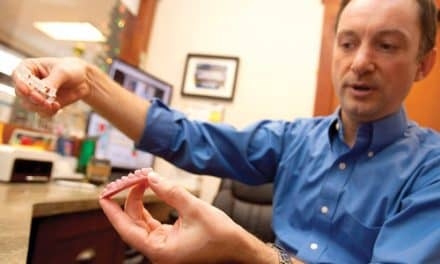by Ari Y. Krug, DMD, and R. Scott Conley, DMD
A review of orthodontic curing lights

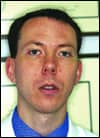
The first visible light sources marketed to cure resins were halogen lights (Figure 1, page 20). Halogen lights use electricity to heat a tungsten filament. The vast majority of the energy is converted to heat, while only a small portion is converted to light. After light filtration, just 1% of the energy is converted to output blue light.5
In 1991, argon lasers became available for curing dental composites. A highly concentrated, coherent beam of 488-nm wavelength, the peak wavelength for polymerization of the photoinitiator in most resins, is produced. This enables argon lasers to be low-powered yet effective in decreasing curing time. Dual-wavelength argon lasers are also available, which operate both at 488 nm for curing and 514 nm for limited soft-tissue procedures such as gingival recontouring and coagulation. Lasers are often highly regulated; local rules may restrict the operation of an argon laser, so be sure to check into your local laws before buying an argon laser.
In the mid 1990s, plasma arc curing lamps (Figure 2, page 22) were introduced as a more affordable, high-speed curing light. Plasma arc curing lights use xenon gas, distilled from liquid air. An electric current passing through the gas ionizes it and creates a plasma of negatively and positively charged particles. Extremely high-powered light is produced (2000 mW/cm2) and filtered to an effective curing wavelength of 450 to 500 nm.6
In 1995, Mills et al first described light-emitting diode (LED) lights for composite polymerization (Figure 3, page 22).7 These instruments use junctions of doped semiconductors to generate visible light.8 No light filtration is required, as the narrow spectrum of light output coincides with that needed for camphorquinone polymerization.
Comparing Bond Strength and Curing Time
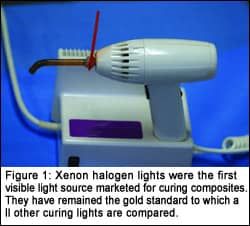
Each of the curing lights produces a different light frequency and intensity, resulting in different curing times required for complete adhesive polymerization. With standard metal brackets, suggested curing times for a complete cure are 15 to 20 seconds on the mesial and distal of each bracket using a halogen light, 10 seconds mesial and distal for LED lights, 4 seconds mesial and distal using an argon laser, and 2 seconds mesial and distal with a plasma arc lamp. Ceramic brackets require half of the total time for each light type, and the light source should be aimed directly through the bracket. Molar bonds require about 150% longer curing times on each the mesial and distal. Recently, a new, high-powered halogen light was claimed to achieve ideal bond strength with only 6 seconds of cure time15; this certainly deserves further investigation. Camphorquinone, the most commonly used photoinitiator, is activated fully by all the light types with these curing times. Other proprietary photoinitiators can be activated with halogen lights, but the newer lights may not be able to achieve a complete bond with reasonable curing times.16 One company has incorporated accessory LED lights set at different wavelengths to overcome this limitation. When selecting curing lights and bonding agents, it is advisable to determine their compatibility.
Design Considerations
Halogen, argon laser, and plasma arc lights all generate significant heat and require a cooling fan. All of these instruments therefore generate significant noise during and after operation. Although halogen lights have powerful fans to cool the unit, the intense heat does damage the light bulb so that the effective bulb life is only about 100 hours.17 The minimal heat generated by LED lights can be easily dissipated by heat sinks, and these lights can therefore operate noiselessly. Heat from curing units is transferred to teeth during bonding procedures; this can, at times, cause discomfort to patients. Although a damaging increase of pulpal temperature does not occur with any of the curing lights, halogen lights do significantly increase the pulpal temperature more than other light sources.18
The energy efficiency and minimal heat generation of LED curing give them many characteristics that the other sources do not have. Because they use minimal energy and do not need a cooling fan, LED lights are able to be marketed as cordless units with a rechargeable battery. And because they do not have any moving parts or light filaments, they better resist vibration and shock.7 As there is no heat damage to the diodes, LED lights are effective for more than 10,000 hours of use with little output degradation.19
Although their exact mechanisms are unknown, argon lasers uniquely restructure enamel-surface characteristics, conferring some demineralization resistance when used for bonding. This protection increases synergistically with the protection imparted by fluoride.20
Each of the various curing-light varieties has a different design. Plasma arc and argon laser curing lights are cumbersome and weigh between 9 and 15 pounds. Many owners of these lights mount the light on a rolling cart or dedicate a single chair for bonding procedures and leave the curing light there. Halogen lights occupy a small footprint and are often mounted chairside by each unit. Corded LED lights have similar space requirements to halogen lights, while their cordless counterparts can be left in any convenient location.
Time and Money
During bonding procedures, chairtime can be correlated with the time required to cure the adhesive. As much as 8 minutes of curing time can be saved by using a plasma arc light rather than a conventional halogen light.13 Between 2 and 3 minutes can be saved with the same procedure using an LED or argon laser rather than a halogen light.13,21
Due to material construction and market variables, there are significant cost differences between the different curing-light options. Halogen lights range from a few hundred dollars to more than a thousand dollars. LED lights start at about $600 and go upward of $1,400. Plasma arc lights cost between $1,600 and $2,300, and argon lasers cost more than $5,000.
Operators need to remember that all curing lights, conventional and high-speed, require adequate eye protection. Both the Center for Devices and Radiological Health of the US Food and Drug Administration22 and the Council on Dental Materials, Instruments and Equipment of the American Dental Association23 recommend wearing protective eyewear to filter harmful short-wavelength light.
Selecting a Curing Light
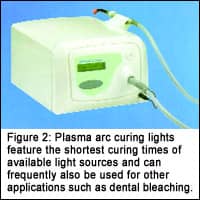
Ari Y. Krug, DMD, is completing his orthodontic residency at Vanderbilt University in June and will be entering private practice in Lakewood, NJ. His areas of research have included curing lights, indirect bonding, distraction osteogenesis, dental bleaching, and chronic inflammation. He can be contacted at [email protected].
R. Scott Conley, DMD, completed his orthodontic residency at Vanderbilt University, where he serves as an assistant professor. He can be reached at [email protected].
References
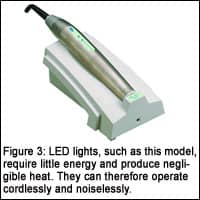
2. Bassiouny MA, Grant AA. A visible light-cured composite restorative. Br Dent J. 1978;145:327–30.
3. Greenlaw R, Way DC, Galil KA. An in vitro evaluation of a visible light-cured resin as an alternative to conventional resin bonding systems. Am J Orthod Dentofacial Orthop. 1989; 96:214–20.
4. Nomoto R. Effect of light wavelength on polymerization of light-cured resins. Dent Mater J. 1997;16: 60–73.
5. Althoff O, Hartung M. Advances in light curing. Am J Dent. 2000;13:77D–81D.
6. Oesterle LJ, Newman SM, Shellhart WC. Rapid curing of bonding composite with a xenon plasma arc light. Am J Orthod Dentofacial Orthop. 2001;119:610–6.
7. Mills RW, Jandt KD, Ashworth SH. Dental composite depth of cure with halogen and blue light emitting diode technology. Br Dent J. 1999;186:388–91.
8. Nakamura S, Mukai T, Senoh M. Candela-class hight brightness InGaN/AlGaN double heterostructure blue-light-emitting diodes. Appl Phys Lett. 1994;64:1687–9.
9. Dunn WJ, Taloumis LJ. Polymerization of orthodontic resin cement with light-emitting diode curing units. Am J Orthod Dentofacial Orthop. 2002;122:236–41.
10. Sfondrini MF, Cacciafesta V, Pistorio A, Sfondrini G. Effects of conventional and high-intensity light curing on enamel shear bond strength of composite resin and resin-modified glass-ionomer. Am J Orthod Dentofacial Orthop. 2001;119:30–5.
11. Manzo B, Liistro G, De Clerck H. Clinical trial comparing plasma arc and conventional halogen curing lights for orthodontic bonding. Am J Orthod Dentofacial Orthop. 2004;125:30–5.
12. James JW, Miller BH, English JD, Tadlock LP, Buschang PH. Effects of high-speed curing devices on shear bond strength and microleakage of orthodontic brackets. Am J Orthod Dentofacial Orthop. 2003;123:555–61.
13. Krug AY, Conley RS. Shear bond strengths using an indirect technique with different light sources. J Clin Orthod. 2005;39:485–7.
14. Cacciafesta V, Sfondrini MF, Scribante A, Boehme A, Jost-Brinkmann PG. Effect of light-tip distance on the shear bond strengths of composite resin. Angle Orthod. 2005;75:352–7.
15. Staudt CB, Mavropoulos A, Bouillaguet S, Kiliaridis S, Krejcid I. Light-curing time reduction with a new high-power halogen lamp. Am J Orthod Dentofacial Orthop. 2005;128:749–54.
16. Hofmann N, Hugo B, Schubert K, Klaiber B. Comparison between a plasma arc light source and conventional halogen curing units regarding flexural strength, modulus, and hardness of photoactivated resin composites. Clin Oral Invest. 2000;4:140–7.
17. Rueggeberg FA, Twiggs SW, Caughman WF, Khajotia S. Lifetime intensity profiles of 11 light-curing units [abstract 2897]. J Dent Res. 1996;75:380.
18. Uzel A, Buyukyilmaz T, Kayalioglu M, Uzel I. Temperature rise during orthodontic bonding with various light-curing units—an in vitro study. Angle Orthod. 2006; 76:330–4.
19. Haitz RH, Craford MG, Wiessman RH. Handbook of Optics, Volume 2. New York, NY: McGraw Hill; 1995:12.1–12.9.
20. Noel L, Rebellato J, Rose D, Sheats RD. The effect of argon laser irradiation on demineralization resistance of human enamel adjacent to orthodontic brackets: an in vitro study. Angle Orthod. 2003;73:249–258.
21. Layman W, Koyama T. A clinical comparison of LED and halogen curing units. J Clin Orthod. 2004;38:385–7.
22. Ellingson O, Landry R, Bostrom R. Unpublished report.
23. Council on Dental Materials, Instruments, and Equipment. The effects of blue light on the retina and the use of protective filtering eyeglasses. J Am Dent Assoc. 1986;112:533–5.





